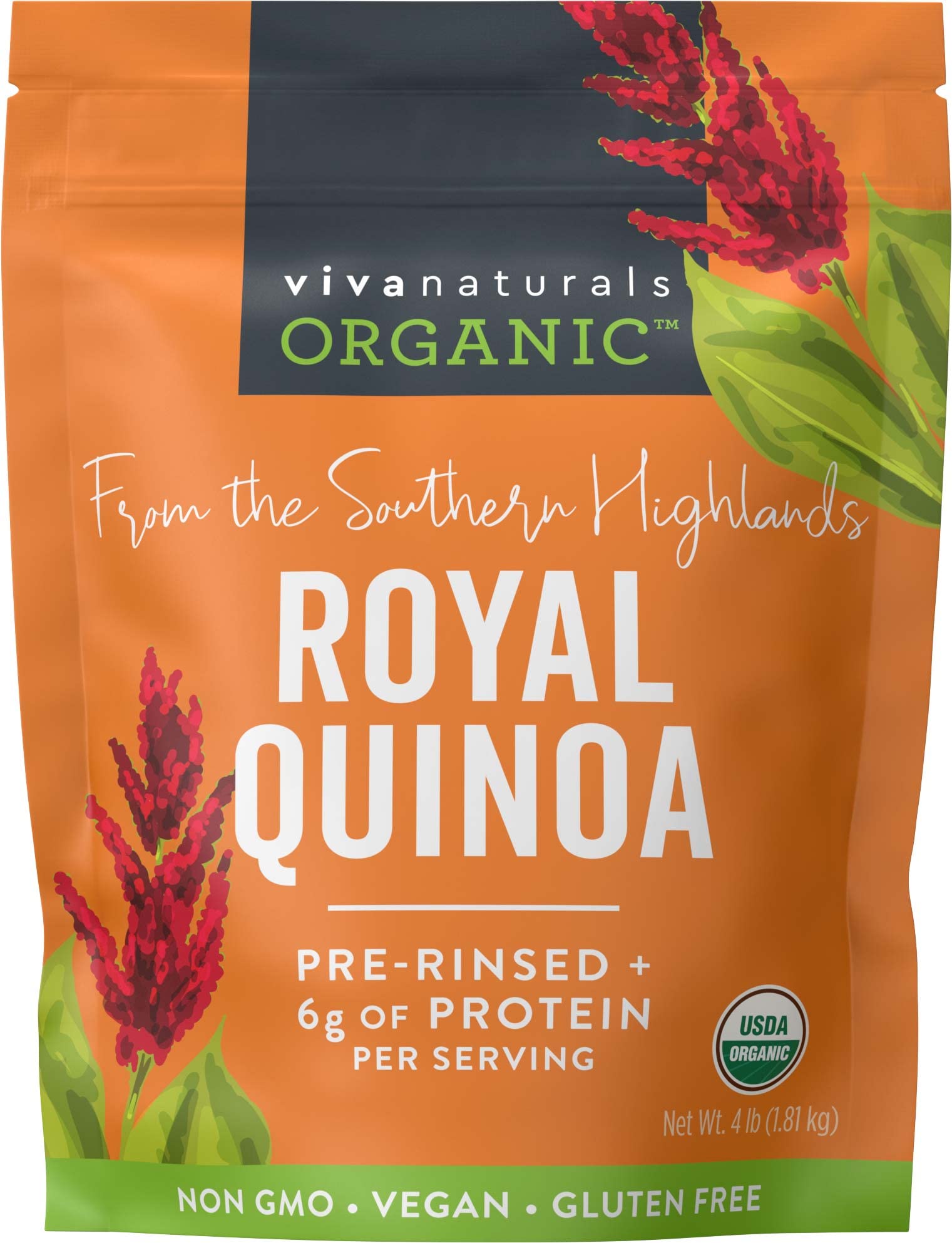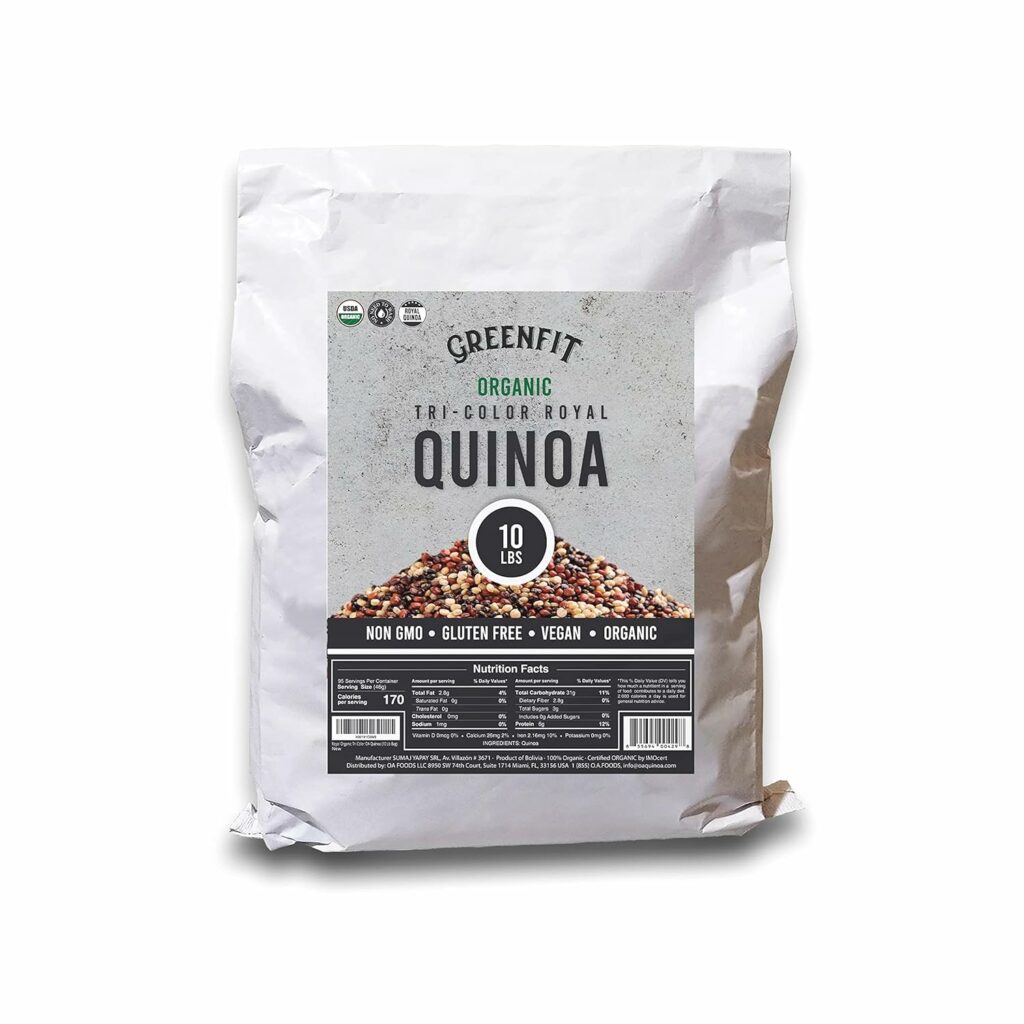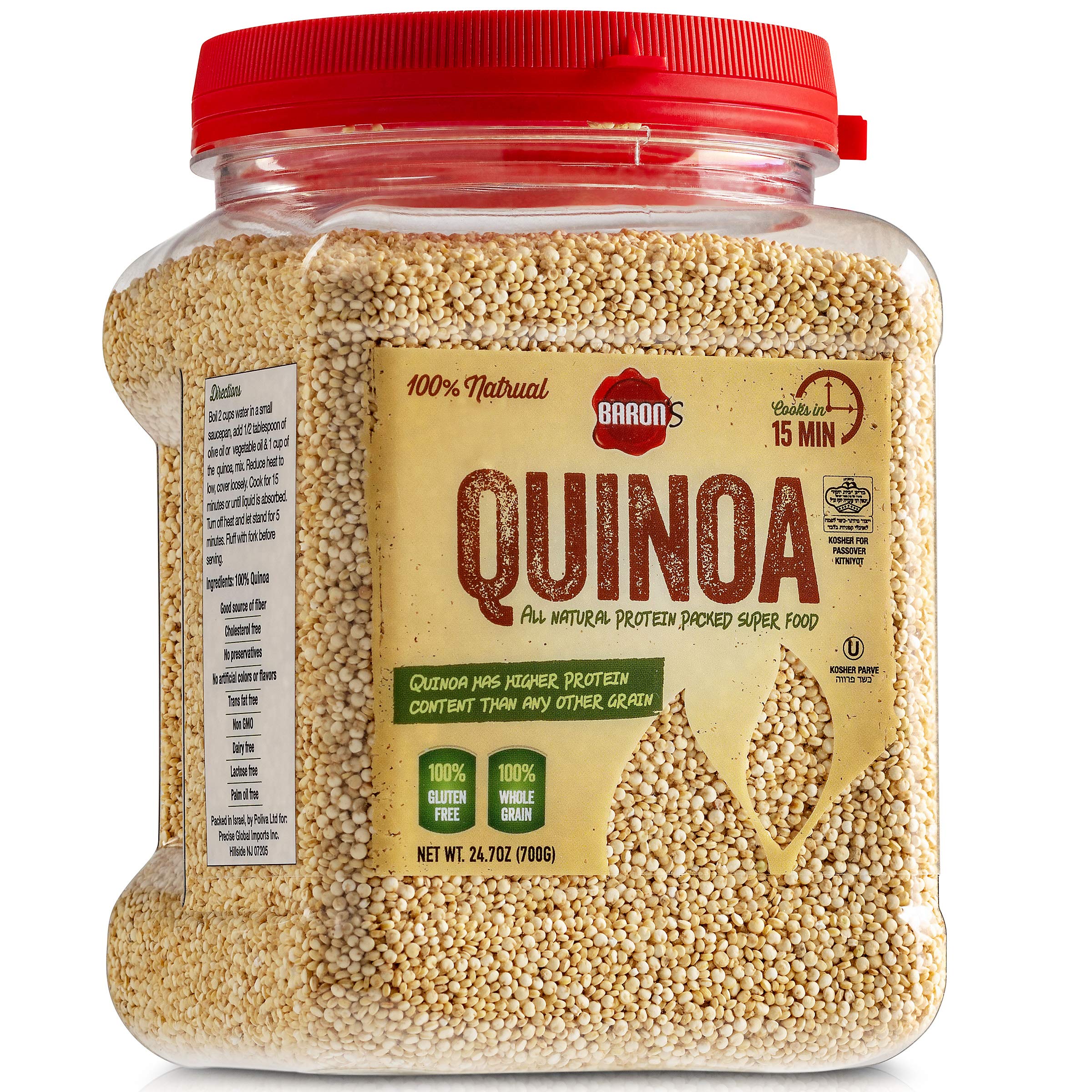Quinoa has become popular as a superfood staple in vegan diets and any health-conscious kitchen. It’s a grain crop grown for its edible seeds, and because it’s not technically a cereal grain, it qualifies as a pseudo-cereal.
It’s precious for anyone following a plant-based diet; it’s gluten-free, high in protein, and one of the few plant foods that contain all nine essential amino acids. It’s a good substitute if you want to switch it up a bit from the best jasmine rice brands.
When shopping for quinoa, the variety is vital. There are three main types: white, red, and black. I also look for pre-rinsed quinoa to save time on preparation, as unrinsed quinoa can taste bitter due to the naturally occurring outer coating of saponins.
What’s critical when selecting the best quinoa is considering its origin and how it’s been processed. Opting for organically grown quinoa ensures it’s free from harmful pesticides and synthetic fertilizers, preserving its natural benefits. Fairtrade certification can also be a bonus, supporting sustainable farming practices and a fair deal for growers.
Ultimately, the best quinoa is the kind that supports not just our health but also ethical farming practices. With that in mind, let’s take a closer look at some of the top contenders I’ve found to be exceptional in quality and taste.
Top Quinoa Picks
Quinoa has been a game-changer in my kitchen, and I’m stoked to share my favorite finds with you.
Whether you’re new to the quinoa scene or a seasoned pro looking for the next best thing, I’ve covered you with the best products. Get ready to boost your meals with these top-notch selections!
BetterBody Quinoa
I just whipped up a batch of this quinoa, and I must say, it’s a game-changer for anyone looking to boost their health with a plant-based diet.
Pros
- Packs a nutritional punch with protein and fiber
- Usable for various diets — kosher, gluten-free, and non-GMO
- Versatile for meals, acting as a rice alternative
Cons
- Requires rinsing and careful preparation
- Potentially more expensive than other grains
- May take some getting accustomed to the taste for new quinoa eaters
After integrating BetterBody Foods Organic Quinoa into my meals, I’ve noticed I’m feeling fuller longer, which is fantastic for my active, plant-based lifestyle. Its complete protein content, including all nine essential amino acids, complements my nutrient needs without resorting to animal products.
As someone who values ethical and wholesome food choices, the fact that it’s USDA organic certified and non-GMO seals the deal. Plus, its low glycemic index means my energy levels don’t crash, unlike after consuming other carbs.
But remember to rinse it well before cooking to avoid bitterness, and if you’re switching from rice, give it some time to win you over. While affordable for organic food, it might stretch your budget more than other grains.
Viva Naturals Organic Quinoa
I found Viva Naturals Organic Quinoa an excellent staple for anyone seeking a healthful, plant-based diet with its versatile use and pleasant, nutty flavor.
Pros
- Packed with protein, making it a powerhouse for vegetarians like me
- Fluffier and more palatable than other quinoa brands I’ve tried
- Convenience is top-notch – it’s pre-washed, so I can cook it directly
Cons
- Only one variety (white quinoa) may disappoint those who prefer a mix
- If not cooked properly, can become mushy
- The price point might be a bit high for budget-conscious shoppers
The Viva Naturals’ fluffy grains cook up perfectly light, avoiding that dreaded mushiness that can happen with lesser-quality grains. The nutty taste of this quinoa is quite pronounced, enriching the flavor profile of my vegan stir-fries and salads.
Their commitment to quality resonates with me; it feels good to know I’m eating organic and sustainably sourced quinoa. I’ve also liked how it works with almost anything: tossed in a salad, as a hearty breakfast, or even as a snack.
One slight hiccup I’ve noticed is the consistency factor – getting the texture just right takes a bit of practice. It is also a bit costly, which might be a deal-breaker for some.
OA Quinoa Tri-Color
Purchasing OA Quinoa’s Tri-Color blend was a brilliant decision for adding a nutritious staple to my kitchen.
Pros
- No extra rinsing necessary
- Contributes to a good cause with profit donations
- Impressive size with a visually appealing blend
Cons
- Packaging could be sturdier
- A bit pricier compared to white quinoa
- May require different cooking times due to varied seed sizes
Cooking OA Quinoa’s was a breeze; I didn’t need to rinse it. I appreciated its substantial size, making for a heartier bite, and the tri-color blend added a pop to my visually stunning and satisfyingly tasty dishes.
I loved knowing that indulging in this quinoa nourished me and supported a cause — with a portion of the profits bolstering children’s charities. As a vegan, I must align my purchases with my values, and OA Quinoa fits right in.
My only qualm was the bag’s durability, as it seemed to succumb easily to wear. It’s also a bit more costly than standard quinoa varieties. Also, paying attention to the cooking time was crucial since the assortment in seed sizes required a slight adjustment to attain the perfect texture.
Baron’s Quinoa
If you’re on the hunt for a high-quality quinoa, let me tell you, Baron’s has nailed it.
Pros
- Quick to cook, saving me precious time in the kitchen.
- It’s a nutritional powerhouse, perfect for my plant-based lifestyle.
- The taste brings a guilt-free nuttiness to my meals.
Cons
- A bit on the pricier side, pushing my grocery budget.
- The texture might not suit everyone; it’s quite distinct.
- May taste slightly stale compared to some other organic options.
Baron’s Whole Grain Quinoa captures all the best aspects in one jar. I was surprised by how fast I had it ready — in about 15 minutes, it was fluffy and eager to soak up the flavors of my stir-fry.
What I adore about this product is that it’s kosher and free from nasties like gluten and GMOs. That aligns perfectly with my conscious lifestyle choices.
However, while I’m all about investing in my health, I did notice the price was a tad high compared to what I usually pay. Also, a hint for fellow quinoa lovers: adjust your seasoning, as this quinoa’s underlying earthiness can differ slightly from other brands.
READ NEXT: Best 9 x 13 Baking Pans to Rock Your Kitchen in 2024
Buying Guide
Where to Purchase
I often find the best selection at my local health food store or organic market. For convenience, online retailers offer a wide variety of options.
Price Point
It’s important to look at the price per ounce rather than just the overall cost. Bulk purchasing often saves money, which is great for a staple like quinoa.
Quinoa Types
There are three main types: white, red, and black. Each has a slightly different taste and texture, so I suggest trying a small amount to see which you prefer.
Origin
I care about where my food comes from. Quinoa is native to South America, with Peru and Bolivia being large producers. The best quinoa is grown in its native environment, so look for those origins.
Certifications
Certifications can be a good indicator of quality. I keep an eye out for:
- Organic: Ensures no synthetic pesticides or fertilizers are used.
- Fair Trade: Supports sustainable farming and fair conditions for farmers.
Nutritional Content
All quinoa is a complete protein, which is fantastic for my plant-based lifestyle, but some brands might fortify their quinoa with additional vitamins and minerals. Check the nutritional label for any extra benefits.






